WR11-2S Module Datasheet
Last Updated on : 2025-07-08 08:27:42download
WR11-2S module is a Wi-Fi and Bluetooth Low Energy (LE) combo module developed by Tuya Smart. It consists of a highly integrated wireless RF chip RTL8711DAF and a few peripheral components, with built-in Wi-Fi and Bluetooth network protocol stacks and various library functions.
Overview
The module is built around a 32-bit low power MCU with 512 KB SRAM, built-in 4 MB flash memory, and various peripheral resources.
WR11-2S is a real-time operating system (RTOS), integrated with all Wi-Fi MAC and TCP/IP libraries. All these resources can help you develop your own embedded Wi-Fi products.
Features
- Built-in low-power 32-bit CPU that also acts as an application processor.
- Clock rate of up to 345 MHz.
- Operating voltage range: 3.3 ± 0.3V.
- Peripherals: 5 PWM pins, 2 UART pins, and 1 ADC pin.
- Wi-Fi connectivity
- IEEE 802.11a/ b/g/n 1x1, 2.4 GHz and 5 GHz.
- Channels 1 to 14 at 2.4 GHz, 36-177 at 5 GHz.
- Support security protocols, including WEP, WPA, WPA2, WPA2 PSK (AES), and WPA3.
- The maximum output power is +18 dBm for IEEE 802.11b.
- Support STA, AP, and STA + AP combo working modes. Except for UNII-2A/2C.
- Two pairing modes are supported, namely Wi-Fi Easy Connect (EZ mode) and access point (AP) mode. Both modes are suitable for pairing with Android and iOS devices.
- Onboard PCB antenna with a gain of 0.95 dBi at 2.4 GHz, and 0.7 dBi at 5 GHz.
- Operating temperature range: -40°C to 85°C.
- Bluetooth connectivity
- Support Bluetooth 5.0.
- Up to +9 dBm output power.
- Onboard PCB antenna with a gain of 0.95 dBi at 2.4 GHz, and sharing the same antenna with Wi-Fi.
- Operating temperature range: -40°C to 85°C.
Scope of applications
- Smart building
- Smart home and electrical appliance
- Smart socket and light
- Industrial wireless control
- Baby monitor
- IP camera
- Smart bus
Module interfaces
Dimensions and footprint
The WR11-2S dimensions are 14.99±0.35mm (W) × 17.91±0.35mm (L) × 3.45±0.15mm (H).
The following figure shows the dimensions and packaging design of the WR11-2S module.
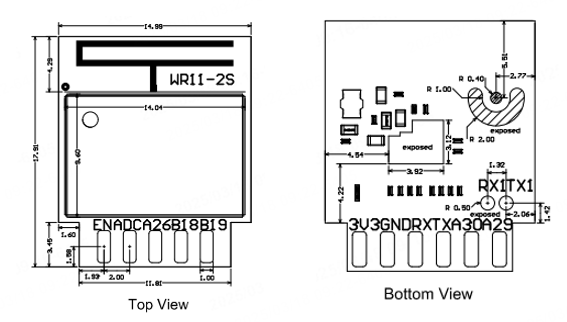
Pin definition
| Pin | Symbol | I/O type | Feature |
|---|---|---|---|
| 1 | 3V3 | P | 3.3V power pin. |
| 2 | PB19 | I/O | Support hardware PWM, corresponding to Pin 39 on the IC. |
| 3 | GND | P | Ground pin. |
| 4 | PB18 | I/O | Support hardware PWM, corresponding to Pin 38 on the IC. |
| 5 | RX0 | I/O | UART_RX0 to receive user data, corresponding to PB21 (Pin 41) on the IC. |
| 6 | PA26 | I/O | Support hardware PWM, corresponding to Pin 12 on the IC. |
| 7 | TX0 | I/O | UART_TX0 to send user data, corresponding to PB20 (Pin 40) on the IC. |
| 8 | PB17 | I/O | ADC pin, corresponding to PB17 (Pin 37) on the IC. |
| 9 | PA30 | I/O | Support hardware PWM, corresponding to Pin 16 on the IC. |
| 10 | CEN | I/O | The reset pin, active low, and pulled up internally. Corresponding to Pin 44 on the IC. |
| 11 | PA29 | I/O | Support hardware PWM, corresponding to Pin 15 on the IC. |
| TP2 | TX1 | I/O | UART_TX1 to print logs, corresponding to PB5 (Pin 35) on the IC. |
| TP3 | RX1 | I/O | UART_RX1 to print logs, corresponding to PB4 (Pin 34) on the IC. |
P indicates the power pin, and I/O indicates the input and output pin.
Electrical parameters
Absolute electrical parameters
| Parameter | Description | Min value | Max value | Unit |
|---|---|---|---|---|
| Ts | Storage temperature | -40 | 85 | °C |
| VBAT | Supply voltage | 3.0 | 3.6 | V |
| Electrostatic discharge voltage (human body model) | TAMB -25°C | - | 2 | kV |
| Electrostatic discharge voltage (machine model) | TAMB -25°C | - | 0.5 | kV |
Normal operating conditions
| Parameter | Description | Min value | Typical value | Max value | Unit |
|---|---|---|---|---|---|
| Ta | Operating temperature | -40 | - | 85 | °C |
| VBAT | Supply voltage | 3.0 | 3.3 | 3.6 | V |
| VIL | I/O low-level input | - | - | 0.8 | V |
| VIH | I/O high-level input | 2.0 | - | - | V |
| VOL | I/O low-level output | 0 | - | 0.3 | V |
| VOH | I/O high-level output | 2.8 | - | 3.6 | V |
| Imax | I/O drive current | - | - | 12 | mA |
Power consumption during continuous transmission and reception
2.4 GHz transmission and reception
| Operating status | Mode | Rate | Transmit/Receive power | Typical value | Unit |
|---|---|---|---|---|---|
| Transmit | 802.11b | 11 Mbit/s | +18dBm | 321 | mA |
| Transmit | 802.11g | 54 Mbit/s | +18dBm | 324 | mA |
| Transmit | 802.11n-HT20 | MCS7 | +17dBm | 312 | mA |
| Transmit | 802.11n-HT40 | MCS7 | +17dBm | 308 | mA |
| Receive | 802.11b | 11 Mbit/s | Continuous reception | 64 | mA |
| Receive | 802.11g | 54 Mbit/s | Continuous reception | 64 | mA |
| Receive | 802.11n-HT20 | MCS7 | Continuous reception | 64 | mA |
| Receive | 802.11n-HT40 | MCS7 | Continuous reception | 64 | mA |
5 GHz transmission and reception
| Operating status | Mode | Rate | Transmit/Receive power | Typical value | Unit |
|---|---|---|---|---|---|
| Transmit | 802.11a | 54 Mbit/s | +17dBm | 372 | mA |
| Transmit | 802.11n-HT20 | MCS7 | +16dBm | 368 | mA |
| Transmit | 802.11n-HT40 | MCS7 | +16dBm | 356 | mA |
| Receive | 802.11a | 54 Mbit/s | Continuous reception | 64 | mA |
| Receive | 802.11n-HT20 | MCS7 | Continuous reception | 64 | mA |
| Receive | 802.11n-HT40 | MCS7 | Continuous reception | 64 | mA |
Operating current
| Working mode | Status (Ta = 25°C) | Average value | Max (Typical) value | Unit |
|---|---|---|---|---|
| Pairing in EZ mode | The module is in EZ mode. The network status indicator blinks quickly. | 58 | 277 | mA |
| Pairing in AP mode | The module is in AP mode. The network status indicator blinks slowly. | 62 | 288 | mA |
| Connected | The module is connected to the cloud. The network status indicator is steady on. | 40 | 414 | mA |
| Disconnected | The module is disconnected from the cloud. The network status indicator is steady off. | 40 | 422 | mA |
RF parameters
Basic RF features
| Parameter | Description |
|---|---|
| Operating frequency | 2.412 GHz to 2.484 GHz(Ch1-11 for US/CA,Ch1-13 for EU/CN), 5.180–5.885 GHz |
| Wi-Fi standard | IEEE 802.11a/b/g/n (Ch1-11 for US/CA,Ch1-13 for EU/CN, and 36–177) |
| Data transmission rate |
|
| Antenna type | Onboard PCB antenna with a gain of 0.95 dBi at 2.4 GHz, and 0.7 dBi at 5 GHz. |
Transmitter (TX) performance
2.4 GHz continuous transmission performance
| Parameter | Min value | Typical value | Max value | Unit |
|---|---|---|---|---|
| RF average output power, 802.11b CCK mode, 11Mbit/s | - | 18 | - | dBm |
| RF average output power, 802.11g OFDM mode, 54Mbit/s | - | 18 | - | dBm |
| RF average output power, 802.11n HT20 mode, MCS7 | - | 17 | - | dBm |
| RF average output power, 802.11n HT40 mode, MCS7 | - | 17 | - | dBm |
| Frequency error | -10 | - | 10 | ppm |
5 GHz continuous transmission performance
| Parameter | Min value | Typical value | Max value | Unit |
|---|---|---|---|---|
| RF average output power, 802.11a OFDM mode, 54Mbit/s | - | 17 | - | dBm |
| RF average output power, 802.11n HT20 mode, MCS7 | - | 16 | - | dBm |
| RF average output power, 802.11n HT40 mode, MCS7 | - | 16 | - | dBm |
| Frequency error | -10 | - | 10 | ppm |
Receiver (RX) performance
RX sensitivity
| Parameter | Min value | Typical value | Max value | Unit |
|---|---|---|---|---|
| PER < 8%, RX sensitivity, 802.11b DSSS mode, 11 Mbit/s | - | -89 | - | dBm |
| PER < 10%, RX sensitivity, 802.11a/g OFDM mode, 54 Mbit/s | - | -77 | - | dBm |
| PER < 10%, RX sensitivity, 802.11n OFDM mode, HT20-MCS7 | - | -74 | - | dBm |
| PER<30.8%, RX sensitivity, Bluetooth 5.0 2 Mbit/s | - | -97 | - | dBm |
Antenna information
Antenna type
Only PCB antenna applies.
Antenna interference reduction
When a PCB antenna is used on a Wi-Fi module, we recommend that the module antenna is at least 15 mm away from other metal components. This can optimize the Wi-Fi performance.
Make sure that the enclosure surrounding the antenna is not traced or filled with copper. Otherwise, the RF performance might be degraded.
Layout principles: No substrate medium exists directly below or above the PCB antenna. The PCB antenna is away from the copper sheet. This can maximize the radiation effect of the antenna.
Packing and production instructions
Mechanical dimensions
Mechanical dimensions of the WR11-2S PCB are 14.99±0.35 mm (W) × 17.91±0.35 mm (L) × 3.45±0.15 mm (H).
The figure below shows the mechanical dimensions of WR11-2S.
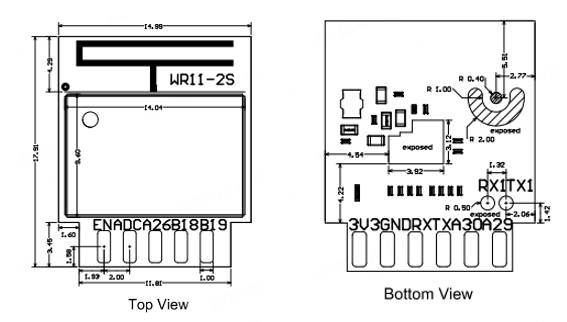
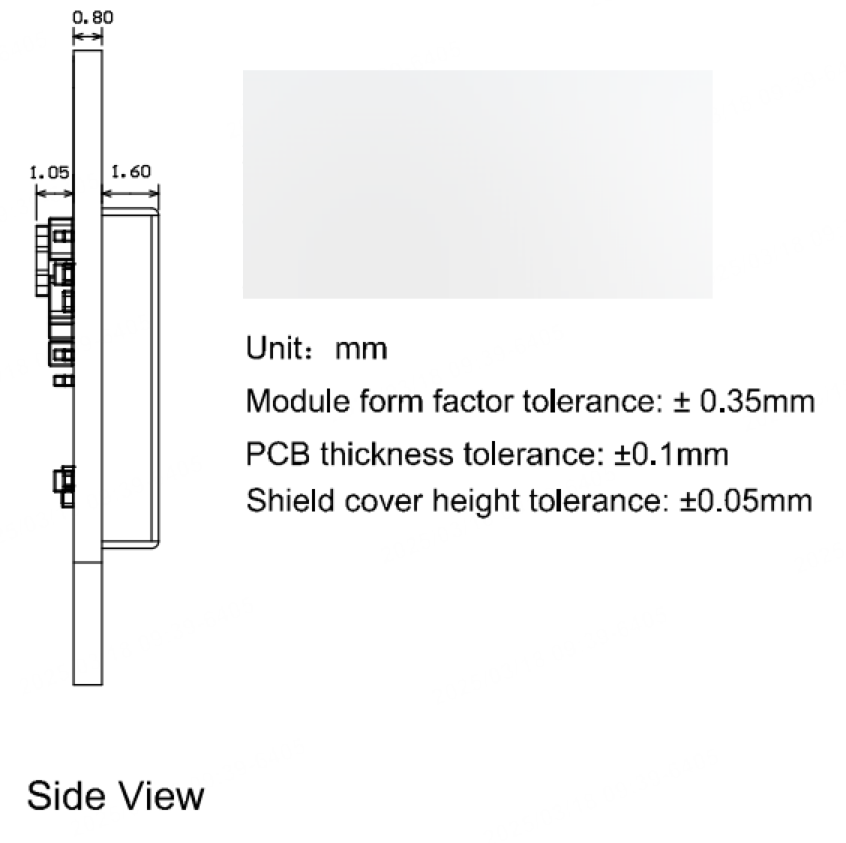
Recommended PCB footprint
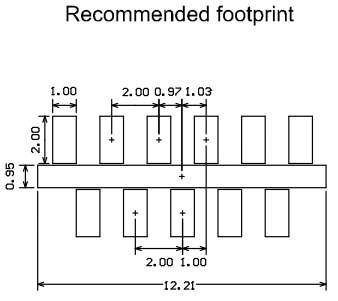
Production instructions
-
For the modules that can be packaged with the surface-mount technology (SMT) or in in-line form, you can select either of them according to the PCB design solutions of customers. If a PCB is designed to be SMT-packaged, package the module with the SMT. If a PCB is designed to use an in-line package, use wave soldering. Complete soldering within 24 hours after the module is unpacked. Otherwise, we recommend that you place the module in a drying cupboard with a relative humidity level below 10%, or pack the module in vacuum again. Then, record the packing time and duration of exposure. The total exposure time cannot exceed 168 hours.
- Instruments or devices required for the SMT process:
- Surface mount system
- SPI
- Reflow soldering machine
- Thermal profiler
- Automated optical inspection (AOI) device
- Instruments or devices required for the wave soldering process:
- Wave soldering device
- Wave soldering fixture
- Constant-temperature soldering iron
- Tin bar, tin wire, and flux
- Thermal profiler
- Instruments or devices required for the baking process:
- Cabinet oven
- Electrostatic discharge (ESD) protection and heat-resistant trays
- ESD protection and heat-resistant gloves
- Instruments or devices required for the SMT process:
-
A delivered module must meet the following storage requirements:
-
The moisture-proof bag must be placed in an environment where the temperature is below 40°C and the relative humidity is lower than 90%.
-
The shelf life of a dry-packaged product is 12 months from the date when the product is packaged and sealed.
-
A humidity indicator card (HIC) is put in the sealed package.
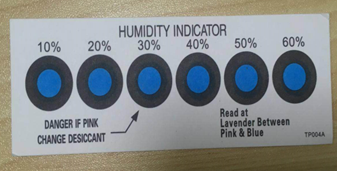
-
-
The module needs to be baked in the following cases:
- The vacuum packaging bag is damaged before unpacking.
- After unpacking, no HIC is found in the packaging bag.
- After unpacking, the HIC indicates a humidity level of 10% or higher. In this case, the circle turns pink on the HIC.
- The total exposure time has lasted for over 168 hours since unpacking.
- More than 12 months have passed since the first sealing of the bag.
-
The baking parameter settings are described below:
- Baking temperature: 40°C for reel packaging with relative humidity ≤ 5%. And 125°C for tray packaging with relative humidity ≤ 5% (use a heat-resistant tray, rather than a plastic container).
- Baking time: 168 hours for reel packaging and 12 hours for tray packaging.
- Temperature for triggering an alert: 50°C for reel packaging and 135°C for tray packaging.
- Production can begin after a module has cooled down to below 36°C under natural conditions.
- If a module remains unused for over 168 hours after being baked, it needs to be baked again.
- If a batch of modules is not baked after exposure for more than 168 hours, do not use wave soldering to solder them. Because these modules are level-3 moisture-sensitive devices, they are very likely to get damp when exposed beyond the allowable time. In this case, if they are soldered at high temperatures, device failure or poor soldering performance might occur.
-
In the whole production process, take electrostatic discharge (ESD) protective measures.
-
To guarantee the pass rate, we recommend that you use the SPI and AOI to monitor the quality of solder paste printing and mounting.
Recommended oven temperature curve
Select a proper soldering technique according to the process. For more information, refer to the recommended oven temperature curve of either reflow soldering or wave soldering. The set temperatures might deviate from the actual temperature measurements. All temperatures shown in this module datasheet are obtained through actual measurements.
Technique 1: SMT process (recommended oven temperature curve of reflow soldering)
Set the oven temperatures according to the following curve.
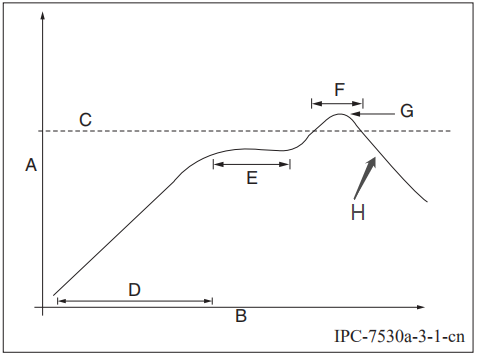
- A: temperature axis
- B: time axis
- C: alloy liquidus temperature from 217°C to 220°C
- D: ramp-up slope from 1°C/s to 3°C/s
- E: keep a constant temperature from 150°C to 200°C for a time period of 60s to 120s
- F: temperature above liquidus temperature for 50s to 70s
- G: peak temperature from 235°C to 245°C
- H: ramp-down slope from 1°C/s to 4°C/s
The curve above is based on solder paste SAC305. For more information about other solder pastes, see the recommended oven temperature curve in the specified solder paste specifications.
Technique 2: Wave soldering process (oven temperature curve of wave soldering)
Set the oven temperatures according to the following temperature curve of wave soldering. The peak temperature is 260°C±5°C.
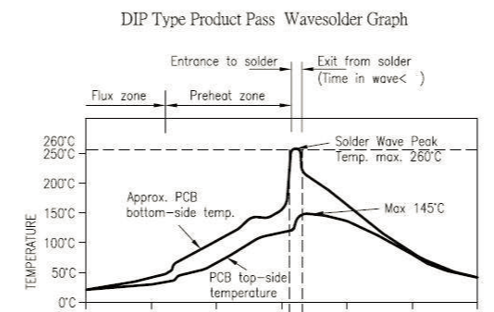
| Suggestions on wave soldering | Suggestions on manual repair soldering | ||
|---|---|---|---|
| Preheat temperature | 80°C to 130°C | Soldering temperature | 360°C ± 20°C |
| Preheat duration | 75s to 100s | Soldering duration | Less than 3s/point |
| Contact duration at the peak | 3s to 5s | N/A | N/A |
| Solder tank temperature | 260°C ± 5°C | N/A | N/A |
| Ramp-up slope | ≤ 2°C/s | N/A | N/A |
| Ramp-down slope | ≤ 6°C/s | N/A | N/A |
Storage conditions
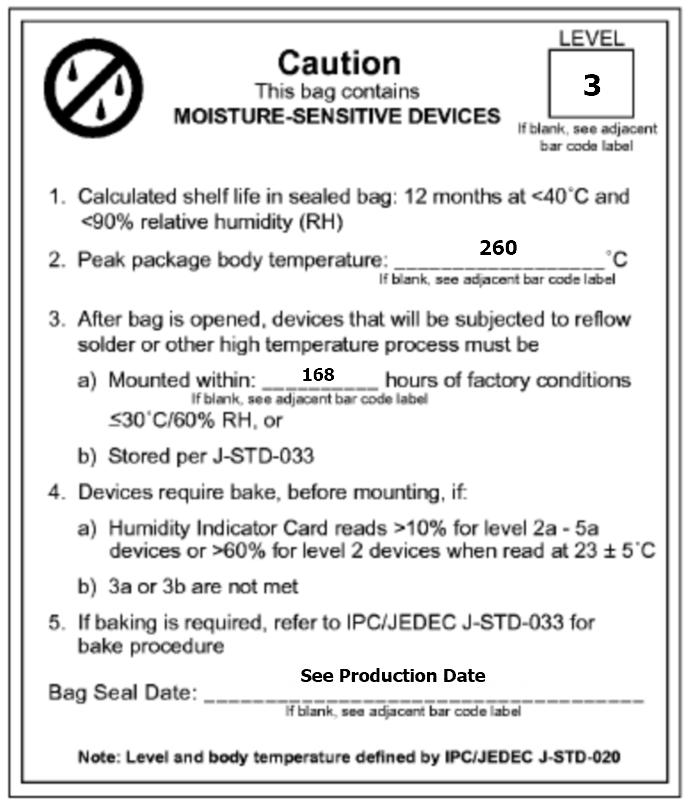
MOQ and packaging information
| Product model | MOQ (pcs) | Shipping packaging | Modules per reel | Reels per carton |
|---|---|---|---|---|
| WR11-2S | 4,400 | Tape and reel | 1,100 | 4 |
Appendix: Statement
Important Notice to OEM integrators
-
This module is limited to OEM installation ONLY.
-
This module is limited to installation in mobile or fixed applications, according to Part 2.1091(b).
-
The separate approval is required for all other operating configurations, including portable configurations with respect to Part 2.1093 and different antenna configurations
-
For FCC Part 15.31 (h) and (k): The host manufacturer is responsible for additional testing to verify compliance as a composite system. When testing the host device for compliance with Part
15 Subpart B, the host manufacturer is required to show compliance with Part 15 Subpart B while the transmitter module(s) are installed and operating. The modules should be transmitting and the evaluation should confirm that the module’s intentional emissions are compliant (i.e. fundamental and out of band emissions). The host manufacturer must verify that there are no additional unintentional emissions other than what is permitted in Part 15 Subpart B or emissions are complaint with the transmitter(s) rule(s).
The Grantee will provide guidance to the host manufacturer for Part 15 B requirements if needed.Important Note
Notice that any deviation(s) from the defined parameters of the antenna trace, as described by the
instructions, require that the host product manufacturer must notify to Tuya that they wish to change the antenna trace design. In this case, a Class II permissive change application is required to be filed by the TUYA, or the host manufacturer can take responsibility through the change in FCC ID (new application) procedure followed by a Class II permissive change application.
End Product Labeling
When the module is installed in the host device, the FCC label must be visible through a window on the final device or it must be visible when an access panel, door or cover is easily re-moved. If not, a second label must be placed on the outside of the final device that contains the following text: “Contains FCC ID: 2ANDL-WR112S” .
The FCC ID can be used only when all FCC compliance requirements are met.
Antenna Installation
(1) The antenna must be installed such that 20 cm is maintained between the antenna and users,
(2) The transmitter module may not be co-located with any other transmitter or antenna.
(3) Only antennas of the same type and with equal or less gains as shown below may be used with this module. Other types of antennas and/or higher gain antennas may require additional authorization for operation.
| Antenna type | BT/Wlan 2.4G | UNII-1 | UNII-2 | UNII-2C | UNII-3 |
|---|---|---|---|---|---|
| PCB | 0.95dBi | 0.7dBi | -0.25dBi | -0.82dBi | -0.44dBi |
In the event that these conditions cannot be met (for example certain laptop configurations or co-location with another transmitter), then the FCC authorization is no longer considered valid and the FCC ID cannot be used on the final product. In these circumstances, the OEM integrator will be responsible for re-evaluating the end product (including the transmitter) and obtaining a separate FCC authorization.
Manual Information to the End User
The OEM integrator has to be aware not to provide information to the end user regarding how to install or remove this RF module in the user’s manual of the end product which integrates this module. The end user manual shall include all required regulatory information/warning as show in this manual.
Federal Communication Commission Interference Statement
This device complies with Part 15 of the FCC Rules. Operation is subject to the following two conditions: (1) This device may not cause harmful interference, and (2) this device must accept any interference received, including interference that may cause undesired operation.
This equipment has been tested and found to comply with the limits for a Class B digital device, pursuant to Part 15 of the FCC Rules. These limits are designed to provide reasonable protection against harmful interference in a residential installation. This equipment generates, uses and can radiate radio frequency energy and, if not installed and used in accordance with the instructions, may cause harmful interference to radio communications. However, there is no guarantee that interference will not occur in a particular installation. If this equipment does cause harmful interference to radio or television reception, which can be determined by turning the equipment off and on, the user is encouraged to try to correct the interference by one of the following measures:
- Reorient or relocate the receiving antenna.
- Increase the separation between the equipment and receiver.
- Connect the equipment into an outlet on a circuit different from that to which the receiver is connected.
- Consult the dealer or an experienced radio/TV technician for help.
Any changes or modifications not expressly approved by the party responsible for compliance could void the user’s authority to operate this equipment. This transmitter must not be co-located or operating in conjunction with any other antenna or transmitter.
List of applicable FCC rules
This module has been tested and found to comply with part 15 requirements for Modular Approval.
The modular transmitter is only FCC authorized for the specific rule parts (i.e., FCC transmitter
rules) listed on the grant, and that the host product manufacturer is responsible for compliance to
any other FCC rules that apply to the host not covered by the modular transmitter grant of
certification. If the grantee markets their product as being Part 15 Subpart B compliant (when it also
contains unintentional-radiator digital circuity), then the grantee shall provide a notice stating that
the final host product still requires Part 15 Subpart B compliance testing with the modular
transmitter installed.
This device is intended only for OEM integrators under the following conditions: (For module device use)
- The antenna must be installed such that 20 cm is maintained between the antenna and users, and
- The transmitter module may not be co-located with any other transmitter or antenna.
As long as 2 conditions above are met, further transmitter test will not be required. However, the
OEM integrator is still responsible for testing their end-product for any additional compliance
requirements required with this module installed.
Radiation Exposure Statement
This equipment complies with FCC radiation exposure limits set forth for an uncontrolled environment. This equipment should be installed and operated with minimum distance 20 cm between the radiator & your body.
Is this page helpful?
YesFeedbackIs this page helpful?
YesFeedback





